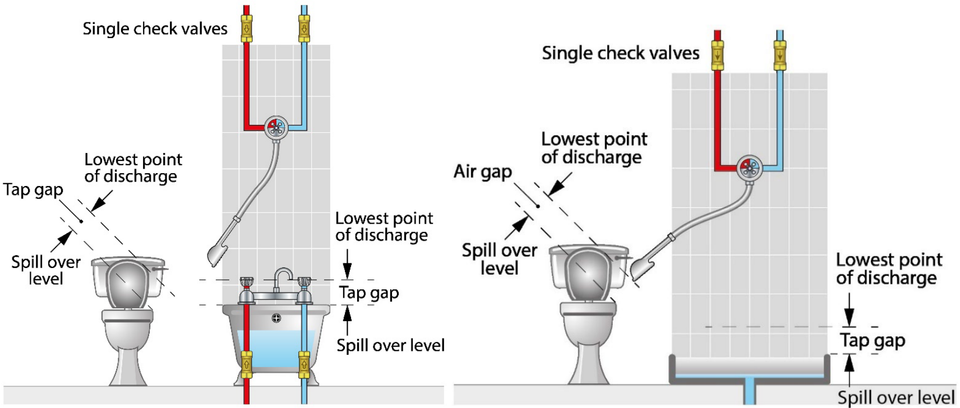All water fittings in a bathroom must be supplied via an appropriate and adequate form of backflow protection, one which is rated either equal to or higher than the highest downstream contamination risk (fluid category) for the type of backflow (back pressure or back siphonage) it is likely to be exposed to.
Although ultimately it is for the local water undertaker to determine what level of backflow protection is required, showers in low risk environments, for example a typical home may be categorised as a fluid category 3 risk, whereas those installed in high risk situations, such as health care premises are a fluid category 5 risk.
If the installation of the shower is notifiable installation advice should be provided as part of the notification process.
If it is not notifiable there remains a legal obligation for the premises owner or occupier to ensure the plumbing work is fully compliant with the water fittings regulations, byelaws in Scotland.
Acceptable methods of backflow protection for showers include:
In all premises a shower arrangement (including those combined with fixed shower head outlets) with a hose handset capable of reaching into a toilet bowl or bidet (irrespective of the bidet design) is considered to be a fluid category 5 risk.
This means unless the shower hose can be permanently restrained or shortened to achieve a specific gap, known as a Type AUK3 tap gap, between the hose handset and spill over level of the toilet or bidet, all water supplies to the shower must be supplied via a suitable fluid category 5 backflow prevention arrangement. For example, a break tank arrangement incorporating a Type AB air gap.

The hose handset being able to reach into a toilet bowl or bidet is not the only contamination risk of concern, preventing backflow from:
water from the bath or shower tray via the hose; and
either the cold or hot water supplies to the shower valve under fault conditions also needs to be addressed.
Typically, the risk of back siphonage of water in the bath or shower tray is tackled by ensuring the hose handset also maintains a suitable tap gap above the spill over level of the bath or shower tray. This gap will vary depending upon both the diameter of the pipework supplying the shower and whether the installation is fluid category 5 (Type AUK3 tap gap) or fluid category 3 (Type AUK2 tap gap).
If the shower handset cannot maintain the required tap gap then alternative backflow protection appropriate to the risk associated with the shower installation is needed.

The risk of cold water pressurising the hot water and hot water accessing the cold water mains supply under fault conditions is usually addressed by the installation of single check valves on the supplies to the shower valve. In the case of fluid category 3 shower installations if double check valves are fitted on the supply to the shower valve this would also address back siphonage via the hose where the required tap gap could not be maintained.
Fluid category 3: Type AUK2 tap gap
Tap or shower connection size | Minimum tap gap |
Up to and including 15 mm (½”) | 20 mm |
Larger than 15 mm (½”) but smaller than 20 mm (¾”) | 25 mm |
20 mm (¾”) or larger | 70 mm |
Fluid category 5 : Type AUK3 tap gap
20 mm or twice the internal diameter of the tap or shower connection whichever is the greater
For example: tap or shower size | minimum tap gap |
8 mm | 20 mm |
10 mm | 20 mm |
12 mm | 24 mm |
15 mm | 30 mm |
20 mm | 40 mm |
25 mm | 50 mm |
As with showers hoses it is important to address the risk of backflow of the bath or shower water via any fixed shower outlets as well as supplies to the shower valve.
The information relating to these two concerns given above also applies to these types of showers, but in the case of fixed shower heads the gap is measured between the lowest point of the shower head and spill over level of the bath or shower tray

We use cookies to give you the best possible experience with Water Regs UK. Some are essential to provide website functions and ensure the website is secure. We also use cookies to help us understand how people use the site and to make improvements. Click "Accept All" to enable recommended settings or click "Manage cookies" to adjust your settings. For more details, see our Cookie Policy.